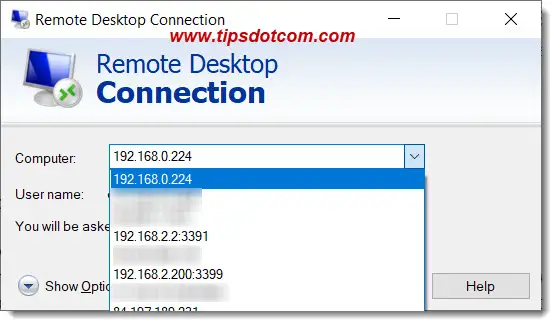- Windows 10 Pro Simultaneous Rdp Connections Windows 10
- Does Windows 10 Allow Multiple Remote Desktop Connections
- Windows 10 Pro Simultaneous Rdp Connections Free
In conclusion, Remote Desktop Connection Manager connects with a single mouse click almost instantly, which greatly facilitates the simultaneous administration of multiple servers. RDCMan is one of the essential free utilities from Microsoft, allowing you to easily manage multiple RDP sessions.
To have concurrent user sessions working in Windows 10, you need to make small changes to termsrv.dll file. This file is located in C:WindowsSystem32 folder. Before modifying termsrv.dllfor the first time, you need to take ownership and assign yourself full permissions. You also need to stop Remote Desktop service (TermService) if it's running. Remote users can connect to their Windows 10 computers through the Remote Desktop Services (RDP) running on the Pro and Enterprise editions (but not on Home/Single Language). But there is a restriction on the number of simultaneous RDP sessions – only one remote user can work at a time. Window Server by default only allows 2 concurrent RDP sessions. If you need more than 2 RDP connections, there are ways to do this but you have to abide by a licensing model. Typically Client Access Licenses (CALs) are used, or for an RDS environment, Windows Virtual Desktop is a good product to use. Enabling Concurrent Sessions allows you to Remote Desktop into a PC that someone else is on, under a different user account, and access the system without di.
I got up a requirement to setup Windows 10 in a cloud from where we want to have concurrent users on it at the same time. It is an easy step for System Administrator on Windows Server, however, as being the normal operating system, it wasn’t easy to fulfill this requirement on Windows 10.
I googled and tried to come up with a solution. I have seen few tools on the internet too but they are not working properly with the latest Windows update too.
In the end, I manage to get it done and thought to share my step on my blog. Hereby, I modify the termsrv.dll file from the System32 folder to get it done.

I tried RDP Wrapper but it didn’t help for the newer version of Windows 10. So the following solution would be convenient.
Solution:
- First backup the DLL file to be on the safe side and take the ownership and provide full rights of termsrv.dll file for your profile.
- After this, you have to stop Terminal Server before modifying it
- Install any HEX editor tool to modify the DLL file. I have used HxD Hex Editor which is freeware too.
- You have to replace the string and be careful while doing it as you are modifying the system file. Strings are different as per Windows 10 build.
- The current Windows 10 build I am working is 1703 and have modified the following things:
- Once you saved the DLL file and reboot the machine, it will work to have concurrent user sessions.
- However, if your Windows version is different as listed above, then kindly check the listed one
Windows 10 Version 1909
Windows 10 Version 1903 (updated v2)
Windows 10 Version 1809 (updated)
Windows 10 Version 1803
Windows 10 Version 1709
Windows 10 Threshold Wave 2 Update
Windows 10 RTM 2015
Hope this will help you guys too.
Feel free to write the comment if you need any support from my end.
Cheers,
Udhy.
A lot of system Administrators actively use the capabilities of the Remote Desktop Protocol (RDP) to manage Windows OS’s remotely. When there are a few managed machines, it is possible to use either the Command line, or save past connections in the Taskbar, for example:
But when the list of servers is large, you need to connect with various accounts, quickly switch from console to console, and using this method becomes inconvenient.
Using RDCMan
To solve this inconvenience (and to systematize connections to remote desktops) you should use the official utility from Microsoft
Among the advantages of RDCMan are the following:
- Ability to create a tree-like structure for presenting a list of servers and open RDP connections;
- Ability to specify own RDP connection parameters for both the individual host and the group of servers;
- Interactive miniatures with desktop of open connections, updated in real time (with mouse control directly in miniature window);
- Possibility to connect the Hyper-V virtual machine console;
- Support for administrative connection (similar to/console and /admin switch of mstsc.exe utility).
RDCMan is small in size, does not require complicated configuration, it is simple and easy to use. Installation of the program does not cause special difficulties. RDCMan is supported by all versions of server operating systems, starting with Microsoft Windows Server 2008 and client OS, starting with Windows Vista. In Windows Server 2003 and Windows XP, you need to upgrade RDP client to version 6.0 (or higher).
How to Manage Multiple RPD sessions via RDCMan?
After installing the RDCMan, create a configuration file. This file will contain all the settings and we will run it to access our tree of the created servers and workstations. To create a configuration file, go to the File menu and select New.
You can create different groups of servers and workstations, and specify specific settings for each group (authorization, appearance, bandwidth etc.). To create a new group, select the created configuration (in this case it’s name Corp), open its properties and select Add group.
A large number of options are available in the settings window that appears. Specify the name of the group (HQ). On the Logon Credentials tab specify the name, password and user domain under which you will log on to all machines in this group. In our case, this will be the Administrator of the theitbros domain.
READ ALSOTo Sign in Remotely, You Need the Right to Sign in Through Remote Desktop ServiceThe active Inherit from parent option allows you to take settings not in the group itself, but in the directory above. If you uncheck the box, then you have to set the settings of this group separately.
In the following tabs, you can change the display settings, set up the gateway, change ports, redirect options etc.
After creating the group, you should add the servers to it, only now we select the group as the object in which we will create the servers. The created server will take all the settings from the group HQ.
Connect to the whole group at once by clicking on its name and selecting Connect Group. On the right pane, a small desktop image will appear.

Windows 10 Pro Simultaneous Rdp Connections Windows 10
The configuration file is a plain text document with the extension *.rdg, formatted in XML and therefore available for manual editing.
In conclusion, Remote Desktop Connection Manager connects with a single mouse click almost instantly, which greatly facilitates the simultaneous administration of multiple servers. RDCMan is one of the essential free utilities from Microsoft, allowing you to easily manage multiple RDP sessions. Here is another one great tutorial on how to
 Recent Posts
Recent Posts Cyril KardashevskyI enjoy technology and developing websites. Since 2012 I'm running a few of my own websites, and share useful content on gadgets, PC administration and website promotion.
Cyril KardashevskyI enjoy technology and developing websites. Since 2012 I'm running a few of my own websites, and share useful content on gadgets, PC administration and website promotion.Does Windows 10 Allow Multiple Remote Desktop Connections
Latest posts by Cyril Kardashevsky (see all)Windows 10 Pro Simultaneous Rdp Connections Free
